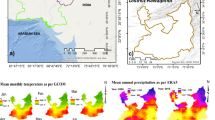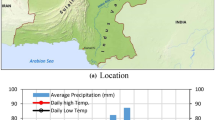Abstract
To accurately determine subsurface soil type and condition for engineering projects, structural safety, and foundation design under static and seismic loading conditions, it is necessary to have a comprehensive workflow that maps and explores the interrelationships between geotechnical and geophysical properties of soil. Although multiple interpolation techniques and mathematical correlations are available for this purpose, there is no globally accepted workflow yet. This study proposes a GIS-based workflow for selecting an interpolation technique and establishing interrelationships among SPT N values, bearing capacity, shear wave velocity (Vs), and groundwater using data from sixty-five boreholes in Lahore city. By evaluating Kriging and Inverse distance weighting (IDW) interpolation techniques using GIS software, the study finds that IDW is more effective than Kriging, with lower mean root mean square error (RMSE) for all studied geotechnical properties. The correlation coefficient of 0.77 between measured and interpolated SPT N values, Vs, and bearing capacity increases confidence in the estimated properties at unsampled locations. Additionally, cross-plots between geotechnical properties demonstrate that they are interdependent and vary with soil type and groundwater depth, which can be helpful for soil characterization, shallow foundation design, and seismic microzonation in the study area. The geotechnical maps and cross-plots produced by this study for Lahore soils are new and consistent with soil types, demonstrating the suitability of the proposed workflow for global use.















Similar content being viewed by others
Data availability
A few datasets may be shared on request.
References
Adhikary PP, Dash CJ (2017) Comparison of deterministic and stochastic methods to predict spatial variation of groundwater depth. Appl Water Sci 7:339–348
Ahmad M, Iqbal Q, Khan FA (2013) Profiling and zoning of geotechnical sub-soil data using geographic information system. Science International 25(3):15–20
Ahmad, M., Rafiq, M., Akram, W., Tasneem, M. A., Ahmad, N., Iqbal, N., & Sajjad, M. I. (2002). Assessment of aquifer system in the city of Lahore, Pakistan using isotopic techniques (No. IAEA-TECDOC--1298).
Ali HM, Shakir RR (2022) Geotechnical map of Thi Qar governorate using geographical information systems (GIS). Materials Today: Proceedings 60:1286–1296
Ali AM, Yadav RN (2016) Influence of groundwater on geotechnical properties of soils: a review. Geomechanics and Engineering 10(5):551–569
Arslan H (2014) Estimation of spatial distrubition of groundwater level and risky areas of seawater intrusion on the coastal region in Çarşamba Plain, Turkey, using different interpolation methods. Environ Monit Assess 186:5123–5134
ASTM Committee D-18 on Soil and Rock. (2017). Standard Practice for Classification of Soils for Engineering Purposes (Unified Soil Classification System) 1. ASTM international.
Athanasopoulos, G. A. (1970). Empirical correlations Vso-NSPT for soils of Greece: A comparative study of reliability. WIT Transactions on The Built Environment, 15.
Awan, T. A., Arshid, M. U., Riaz, M. S., Houda, M., Abdallah, M., Shahkar, M., ... & Azab, M. (2022). Sub-surface geotechnical data visualization of inaccessible sites using GIS. ISPRS International Journal of Geo-Information, 11(7), 368.
Bowles, J. E. (1997). Foundation analysis and design, McGraw-Hill International Editions, Civil Engineering Series, Fifth Editions, United States of America.
Cui Y, Gao Q, Zhang Y, Su X (2019) Investigation of soil variability and its effect on geogrid-reinforced soil retaining wall. J Mater Civ Eng 31(2):04018344
Das, B. M., & Sivakugan, N. (2018). Principles of foundation engineering. Cengage learning.
Das BM, Sobhan K (2014) Principles of geotechnical engineering, SI. Cengage Learning, Boston
Desa, U. N. (2018). World urbanization prospects 2018. United nations department for economic and social affairs.
Dikmen Ü (2009) Statistical correlations of shear wave velocity and penetration resistance for soils. J Geophys Eng 6(1):61–72. https://doi.org/10.1088/1742-2132/6/1/007
Duncan JM, Wright SG (2011) Earthquake geotechnical engineering design. CRC Press
Guyer, J. P. (2015). Groundwater and Geotechnical Engineering. The National Academies Press.
Hanumantharao C, Ramana G (2008) Dynamic soil properties for microzonation of Delhi. India Journal of Earth System Science 117(2):719–730
Hasancebi N, Ulusay R (2007) Empirical correlations between shear wave velocity and penetration resistance for ground shaking assessments. Bull Eng Geol Env 66(2):203–213
Hassan W, Alshameri B, Nawaz MN, Ijaz Z, Qasim M (2022) Geospatial and statistical interpolation of geotechnical data for modeling zonation maps of Islamabad. Pakistan Environmental Earth Sciences 81(24):547
Hayashi, K., Inazaki, T., Kitao, K., & Kita, T. (2013, September). Statistical estimation of geotechnical soil parameters in terms of cross-plots of S-wave velocity and resistivity in Japanese levees. In 2013 SEG Annual Meeting. OnePetro.
Ijaz Z, Zhao C, Ijaz N, Rehman Z, u., & Ijaz, A. (2021) Spatial map** of geotechnical soil properties at multiple depths in Sialkot region. Pakistan Environmental Earth Sciences 80(24):787
Imai, T. (1977). P and S wave velocities of the ground in Japan. Proc. 9th ICSMFE, Tokyo, 1977, 2, 257–260.
Jafari MK, Shafiee A, Razmkhah A (2002) Dynamic properties of fine grained soils in south of Tehran. Journal of Seismology Earthquake Engineering 4(1):25–35
Kadwai, S., & Siraj, A. (1964). The Geology of Bari Doab, West Pakistan. WAPDA Water Soil Investigation Division. Bulletin (8).
Kalinski, M. E. (2011). Soil mechanics: lab manual (No. Ed. 2). John Wiley & Sons.
Kang T, Suh MS (2021) Retrieval of High-Resolution Grid Type Visibility Data in South Korea Using Inverse Distance Weighting and Kriging. Korean Journal of Remote Sensing 37(1):97–110
Kaniraj SR, Thandaveswara BS (2015) Correlation of shear wave velocity with SPT N-value and soil properties. International Journal of Earth Sciences and Engineering 8(2):273–279
Khalid MH, Alshameri B, Abid U (2021) Application of Kriging for development of SPT N value contour maps and USCS-based soil type qualitative contour maps for Islamabad. Pakistan Environmental Earth Sciences 80(11):1–13
Khan HU, Rashid I, Israr J, Zhang G (2022) Geotechnical characterization and statistical evaluation of alluvial soils of Lahore. Arab J Geosci 15(9):845
Kusuma GP, Kurniawan W (2020) Effect of groundwater on the shear strength of soft clay. J Phys: Conf Ser 1547(1):012025. https://doi.org/10.1088/1742-6596/1547/1/012025
Ma Q (2009a) Soil particle composition and geotechnical properties of permafrost in Beiluhe basin, Tibetan Plateau. Cold Reg Sci Technol 57(2–3):79–86
Ma YZ (2009b) Propensity and probability in depositional facies analysis and modeling. Math Geosci 41:737–760
Malik, A. (2015). Geotechnical statistical evaluation of Lahore site data and deep excavation design.
Massonnat, G. J. (1999, October). Breaking of a paradigm: geology can provide 3D complex probability fields for stochastic facies modelling. In SPE Annual Technical Conference and Exhibition. OnePetro.
Mhaske, S. Y., & Choudhury, D. (2011). GIS-GPS based map of soil index properties for Mumbai. In Geo-frontiers 2011: Advances in geotechnical engineering (pp. 2366–2375).
Ohba, S., & Toriumi, I. (1970, December). Dynamic response characteristics of Osaka Plain. In Proceedings of the annual meeting AIJ (in Japanese) (Vol. 12).
Ohta Y, Goto N (1978) Empirical shear wave velocity equations in terms of characteristic soil indexes. Earthquake Eng Struct Dynam 6(2):167–187
Rafi, A., Dauji, S., & Bhargava, K. (2020). Estimation of SPT from coarse grid data by spatial interpolation technique. In Geotechnical Characterization and Modelling: Proceedings of IGC 2018 (pp. 1079–1091). Springer Singapore.
University of Engineering and Technology (UET) (1998–2008). Geotechnical Investigation Reports of Various Sites Located in Lahore. Department of Civil Engineering, University of Engineering and Technology (UET) Lahore.
National Engineering Services Pakistan (NESPAK) (1986–2008). Geotechnical Investigation Reports of Various Sites Located in Lahore. National Engineering Services Pakistan (Pvt.) Ltd. (NESPAK) Lahore.
Seed, H. B., & Idriss, I. M. (1981, October). Evaluation of liquefaction potential sand deposits based on observation of performance in previous earthquakes. In ASCE national convention (MO) (pp. 481–544).
Shafique U, Khan M, Mustafa A, Arif S (2012) Engineering geological characterization of Lahore soil, based on geotechnical testing and mineralogical composition using X-ray diffraction. Pak J Sci 64(3):191
Sharma B, Rahman SK (2016) Use of GIS based maps for preliminary assessment of subsoil of Guwahati city. Journal of Geoscience and Environment Protection 4(05):106
Singh A, Noor S, Chitra R, Gupta M (2018) Applications of GIS in Geotechnical Engineering: Some Case Studies. Int J Sci Eng Sci 2:34–38
Soga K, O’Brien GY (2005) The effects of groundwater level fluctuations on the behavior of soils: a review. Geotechnique 55(6):455–467
Sun Y, Kang S, Li F, Zhang L (2009) Comparison of interpolation methods for depth to groundwater and its temporal and spatial variations in the Minqin oasis of northwest China. Environ Model Softw 24(10):1163–1170
Terzaghi, K., Peck, R. B., & Mesri, G. (1996). Soil mechanics in engineering practice. John wiley & sons.
Uma Maheswari R, Boominathan A, Dodagoudar GR (2010) Use of surface waves in statistical correlations of shear wave velocity and penetration resistance of Chennai soils. Geotech Geol Eng 28:119–137
Varouchakis ΕA, Hristopulos DT (2013) Comparison of stochastic and deterministic methods for map** groundwater level spatial variability in sparsely monitored basins. Environ Monit Assess 185:1–19
Zhang X, Srinivasan R (2009) GIS-based spatial precipitation estimation: a comparison of geostatistical approaches. J Am Water Resour Assoc 45(4):894–906
Funding
The authors declare that no funds, grants, or other support were received during the preparation of this manuscript.
Author information
Authors and Affiliations
Contributions
All authors contributed to the study conception and design. Material preparation, data collection, and analysis were performed by Muhammad Daniyal and Ghulam M. Sohail. The first draft of the manuscript was written by Muhammad Daniyal. H. M. A. Rashid commented on original and revised versions of the manuscript. All authors read and approved the final manuscript.
Corresponding author
Ethics declarations
Conflict of interest
The authors have no relevant financial or non-financial interests to disclose.
Additional information
Publisher's Note
Springer Nature remains neutral with regard to jurisdictional claims in published maps and institutional affiliations.
Rights and permissions
Springer Nature or its licensor (e.g. a society or other partner) holds exclusive rights to this article under a publishing agreement with the author(s) or other rightsholder(s); author self-archiving of the accepted manuscript version of this article is solely governed by the terms of such publishing agreement and applicable law.
About this article
Cite this article
Daniyal, M., Sohail, G.M. & Rashid, H.M.A. GIS-based map** of geotechnical and geophysical properties of Lahore soils. Environ Earth Sci 82, 540 (2023). https://doi.org/10.1007/s12665-023-11201-w
Received:
Accepted:
Published:
DOI: https://doi.org/10.1007/s12665-023-11201-w






